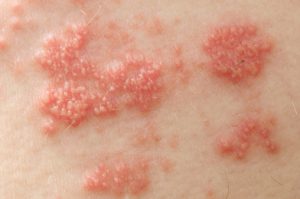 It is likely that when you were a child you experienced chicken pox, a mostly benign condition that made you extremely itchy and required you to miss a week or two of school.
It is likely that when you were a child you experienced chicken pox, a mostly benign condition that made you extremely itchy and required you to miss a week or two of school.
Chicken pox—varicella zoster virus—is an airborne disease that is characterized by small itchy blisters that form on the skin and eventually scab over. They occur all over the body, usually spreading over the chest, back, and face, and comes with symptoms of fatigue, fever, and headaches. It is not too long, however, before these signs and symptoms begin to disappear. It typically takes about 10 days after the initial onset until we are then told that we will never have to worry about chicken pox ever again. Sadly, this is not exactly true, as when we age and our body’s immune system becomes more susceptible to infection, the varicella virus may rear its head once again, but this time by a new name: Shingles.
Advertisement
Shingles occurs due to the exact same virus that causes chicken pox and can strike despite having chicken pox as a kid. It is not contracted from another person, but is caused by a reactivation of the varicella zoster virus within the body that had been kept at bay by the immune system. However, if the immune system were to become compromised—as it does due to aging, immunosuppressive therapy, or even psychosocial stress—the varicella zoster virus may reactivate.
While shingles does cause a rash characterized by blistering and inflammation—similar in fashion to childhood chicken pox—it does so in a dermatomal distribution, or an area of the skin supplied by a single spinal nerve. Shingles will only appear in a specific linear or belt-like region of the body (classified as dermatomes) that never crosses the midline. It is typically seen around the midsections of the abdomen or torso but can appear on the face, eyes, or other parts of the body. These blisters can become very painful, eventually scabbing over and possibly leaving a scar and discoloration.
It is important to note that acute cases of shingles with early stages of rash formation are considered possibly contagious. Other can contract the virus by direct contact with open sores of the shingles rash. While people exposed to shingles will only likely develop chicken pox, certain people like pregnant women, newborns, and anyone with weakened immune systems are at significant risk.
While there is no cure for shingles, your doctor may prescribe antiviral medication (e.g. Acyclovir, Valacyclovir) to speed up the healing process. They may also provide medication to reduce the pain associated with the disease, such as capsaicin cream, numbing agents, and codeine. Shingles lasts 2–6 weeks in the majority of cases and occurs only once in a person’s lifetime, but multiple outbreaks are possible. Those who have never had chicken pox are advised to get the varicella vaccine, however, it doesn’t guarantee prevention of chicken pox or shingles.
Related: Shingles vs. eczema, differences in symptoms, causes, and treatments
